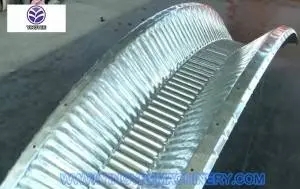
Coil Metal Cut to Length Lines An Efficient Solution for Metal Processing
In the fast-paced world of manufacturing and metal processing, efficiency and precision are crucial. One of the essential components that facilitate these objectives is the coil metal cut to length line. This advanced processing line is designed to take large rolls of metal coils and convert them into shorter, more manageable lengths, ready for further processing or direct shipment. This article will explore the machinery, benefits, applications, and future of coil metal cut to length lines.
Understanding the Technology
A coil metal cut to length line consists of several key components working in harmony to deliver precise cuts of metal strips. The process typically begins with the unwinding of the metal coil. Large coils, made from various materials like steel, aluminum, or copper, are unwound using precision equipment that ensures minimal deformation.
Following the unwinding process, the metal strip is fed through a series of rollers that guide it into the cutting area. The cutting mechanism can be mechanical or hydraulic, depending on the specific requirements of the operation. High-precision cutting tools make sure that the metal strips are cut at specified lengths accurately. After cutting, the metal is often processed through a leveling station to remove any residual curl or distortion, ensuring flatness and readiness for subsequent operations, such as punching, shearing, or forming.
A key feature of many cut-to-length lines is automated controls that allow operators to specify dimensions and adjust settings quickly. This level of technological integration enhances operational efficiency while ensuring consistent product quality.
Benefits of Coil Metal Cut to Length Lines
The adoption of coil metal cut to length lines comes with a multitude of advantages. One significant benefit is improved efficiency. Traditional methods of cutting metal to length often involve handling smaller pieces manually, which is labor-intensive and time-consuming. By automating the process, manufacturers can produce higher volumes in shorter timeframes, decreasing labor costs and increasing overall productivity.
Additionally, precision is a standout benefit of these lines. The accuracy of cutting reduces material waste. Every millimeter counts in manufacturing, and inefficient cutting can lead to substantial losses over time. The cut-to-length process minimizes scrap metal and optimizes the use of raw materials, which is not only cost-effective but also environmentally sustainable.

Moreover, cut-to-length lines can handle a variety of materials and thicknesses. This versatility allows manufacturers to cater to different market needs without investing in multiple pieces of equipment. Whether dealing with thin aluminum sheets or thicker steel plates, modern coil metal cut to length lines can be adjusted to meet specific requirements.
Applications Across Industries
The versatility of coil metal cut to length lines translates into a wide array of applications. Industries like automotive, construction, and appliances increasingly rely on these systems for producing parts and components.
In the automotive sector, for instance, high-strength steel sheets are cut to length for fabrication into panels and structural components. In construction, steel and aluminum cut to length pieces are crucial for creating frameworks and building materials. Similarly, appliance manufacturers utilize these lines to acquire metal sheets for housing and components, ensuring they meet specific dimensions for assembly.
The Future of Coil Metal Cut to Length Lines
As technology evolves, the future of coil metal cut to length lines looks promising. Innovations in automation and artificial intelligence are likely to enhance process efficiency further. Smart factories that leverage Industry 4.0 principles will see these lines integrated with data analytics to predict maintenance needs, optimize production schedules, and improve quality control.
In addition, the increasing demand for customized products means that flexibility will be essential for future cut-to-length machinery. Advancements in machine learning could allow these systems to adapt to varying sizes and specifications on-the-fly, catering to the growing trend of customization in manufacturing.
Conclusion
Coil metal cut to length lines are integral to modern manufacturing and metal processing. They provide a reliable, efficient, and precise means of cutting metal coils into usable lengths, enabling industries to meet their production demands effectively. With ongoing technological advancements, these lines will likely continue to evolve, leading to even greater efficiencies and possibilities in metal processing. As manufacturers embrace these innovations, they set the stage for a more productive and sustainable future in metal fabrication.